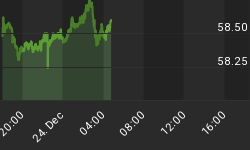Are you sold on gold? The precious metal outperformed every major equity index in the world in 2008. The question is, can gold -- and other precious metals -- keep on flying? Or would buying today be buying high and selling low?
Precious metals have always been intriguing to investors because they tend to hold their value. In times of geopolitical crisis or currency devaluation, for example, the value of paper money might fluctuate, but a hard asset will always be worth something. As a result, historically, precious metals have been considered a "safe haven" in times of economic and financial instability.
That brings us to why gold is on a tear today. It declined in 2008 and early 2009 as panicked investors rushed into cash in an attempt to weather the financial crisis. But sometime in the middle on 2009, when investors began to move their money from the sidelines, gold started to rally. It returned 32.59% through the third quarter of 2009, vs. 19.26% for stocks.
The question is, where can we expect gold to go from here? In order to predict whether gold prices will skyrocket or come crashing down, it's important to understand the principal factors that affect the price of any commodity: supply and demand.
The supply side of the equation is not particularly relevant in regard to gold because gold supplies remain fairly constant. That's because production has not significantly increased due to a lack of new mining sites. Should supplies increase, however, investors may want to be cautious.
The demand side of the equation, then, is the one gold investors must look at. And as we noted above, demand for gold tends to increase when investors have a lack of confidence in the U.S. economy and financial markets.
That's certainly the case today. In fact, we see two factors, that could lead gold to outperform in the near future: inflation and currency devaluation. In response to the financial crisis of 2008 and 2009, the Federal Reserve injected massive amounts of liquidity into the money markets. Ultimately, that increase in the money supply could devalue the U.S. dollar and lead to inflation. In fact, the U.S. dollar is already shockingly low. On October 14, 2009, it fell to a 14-month low against the euro, hitting $1.4947, the weakest since August 2008, according to Bloomberg. And while inflation is not yet a problem, economists are on the lookout for it.
These conditions led Standard & Poor's (S&P) to raise its gold price assumption for 2010 from $750 per ounce to $800 per ounce. "Investors seeking a hedge against inflation risks and uncertainty in the financial markets continue to support gold prices," the S&P analysts write. "The metal's properties as a safe haven, and to a lesser extent the demand for jewelry, also support its longer-term price prospects."
S&P's estimate, however, may be on the low side. As of November 2009, gold was trading at more than $1,000 per ounce. And since gold exceeded $1,000 per ounce level, the price has been extremely resilient, with no meaningful pullback seen. There have been periods of profit-taking, but increased demand quickly appears on any weakness in price.
In sum, then, good old-fashioned gold fever is back -- and investors who are looking for a promising trend may want to consider investing in it and other precious metals.
But don't consider gold an investment only for troubled times. One of the greatest advantages of precious metals exists regardless of economic and market conditions. Precious metals tend to perform differently from other assets. As a result, investing in precious metals may be a good diversification strategy for a portfolio comprised mainly of stocks, bonds and real estate -- in all environments.
This article was written by OilPrice.com - who offer free information and analysis on Energy and Commodities. The site has sections devoted to Fossil Fuels, Alternative Energy, Metals, Oil prices and Geopolitics. To find out more visit their website at: http://www.oilprice.com
















